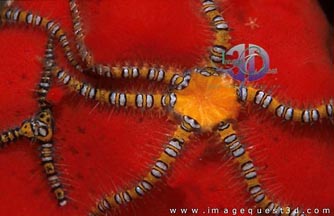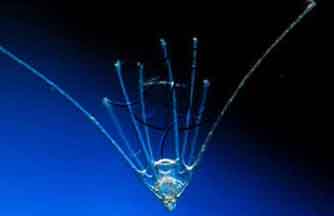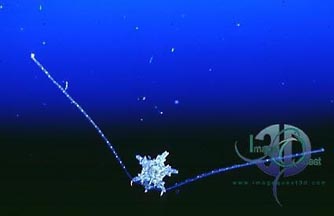|
The brittlestar, a relative of the starfish,
seems to be able to flee from predators in the murky ocean
depths without the aid of eyes. Now marine scientists have
discovered its secret: its entire skeleton forms one gigantic
eye.
A new study shows that a brittle star species
called Ophiocoma wendtii has a skeleton with crystals
that function as a visual system, apparently furnishing the
information that lets the animal see its surroundings and
escape harm. Now it could provide pointers to making the perfect
lens, invaluable in fibre-optic communications.
The spindly arms of brittlestars may double
as a primitive eye thanks to microscopic calcite crystals
in its exoskeleton that focus light. These tiny lenses rival
the best that human technology can offer, and their discovery
solves a longstanding mystery about the behaviour of these
exclusively marine invertebrates.
"This is a big breakthrough for brittlestars
because no one knew how they detect light", observes
Stephen Stancyk, a marine biologist at the University of South
Carolina in Columbia.
Unlike their starfish cousins, brittlestars
can move rapidly by walking on their arms, and they tend to
avoid brightly lit places. "They're very delicate and
they don't come out of their hiding places except at night
because they get chewed on by lots of different animals,"
Stancyk says.
With the help of a scanning electron microscope,
the team of researchers, from Bell Laboratories in New Jersey,
found arrays of calcite crystals each about 10 to 15 micrometres
in diameter, incorporated into the animal's skeleton.
|
These crystals were found to act as optical
lenses, manipulating and focusing light. The focusing isn't
random - the light appears to fall on bundles of nerves that
control movement and the brittlestar interprets the surrounding
light and knows whether to move or stay put.
"This is an exellent example of something
that we can learn from nature," says Federico Capasso,
of Bell Laboratories in New Jersey, whose colleague Joanna
Aizenberg led the work, which was recently reported in Nature
magazine. "These tiny calcite crystals are nearly perfect
optical microlenses, much better than any we can manufacture
today."
Aizenberg made her discovery by polishing a piece of skeleton
and placing it on light-sensitive material used in the manufacture
of computer chips.When light was shone through it it produced
a pattern of spots - evidence that the crystals were acting
as lenses and focusing light. The light is concentrated on
a tiny spot about 5 micrometres below the bottom of the crystal.
This correspondes exactly to the position of the nerve bundles
in the brittlestar's body.
Approximately ten thousand spherical crystals cover the five
limbs and central body - comprising one large compound eye.
The vast number of lenses ensures that the brittlestar is
aware of all light sources, surrounding it.
|

Orange-banded Brittle Star (Ophiothrix)

Brittle Star Larva

Metamorphosing Brittle Star Larva
|